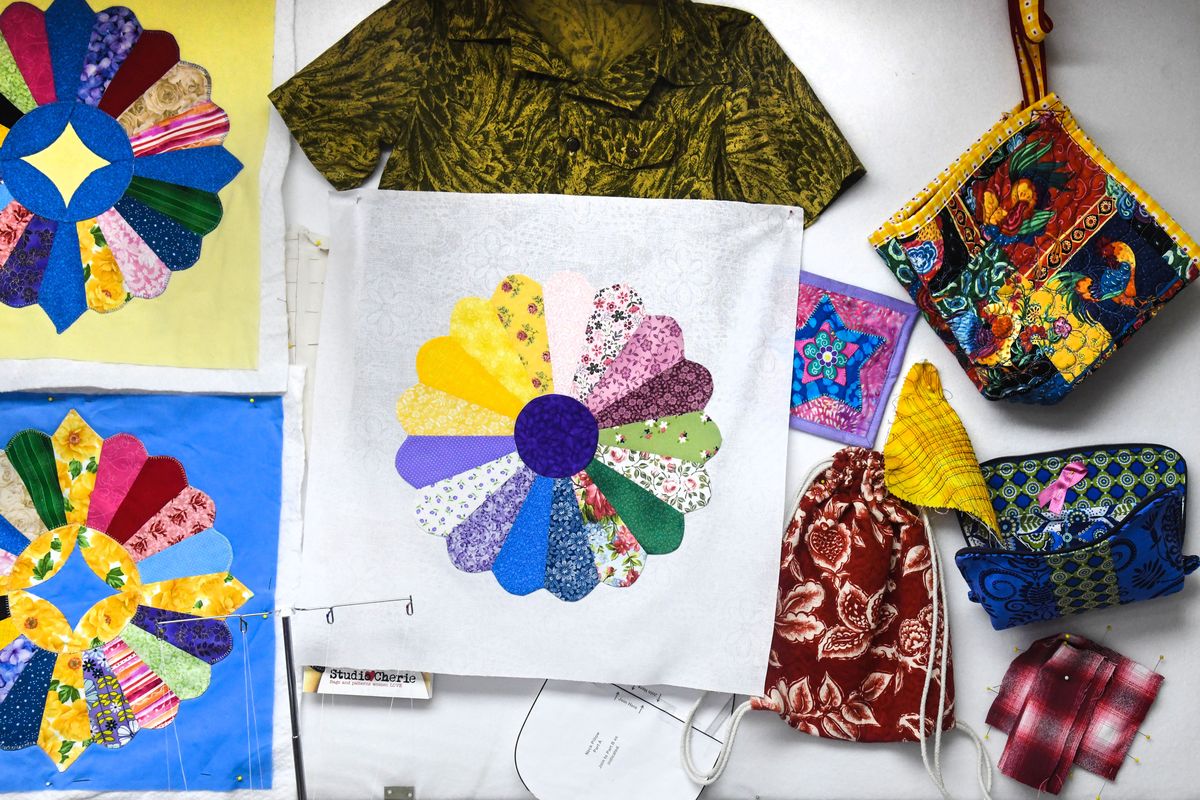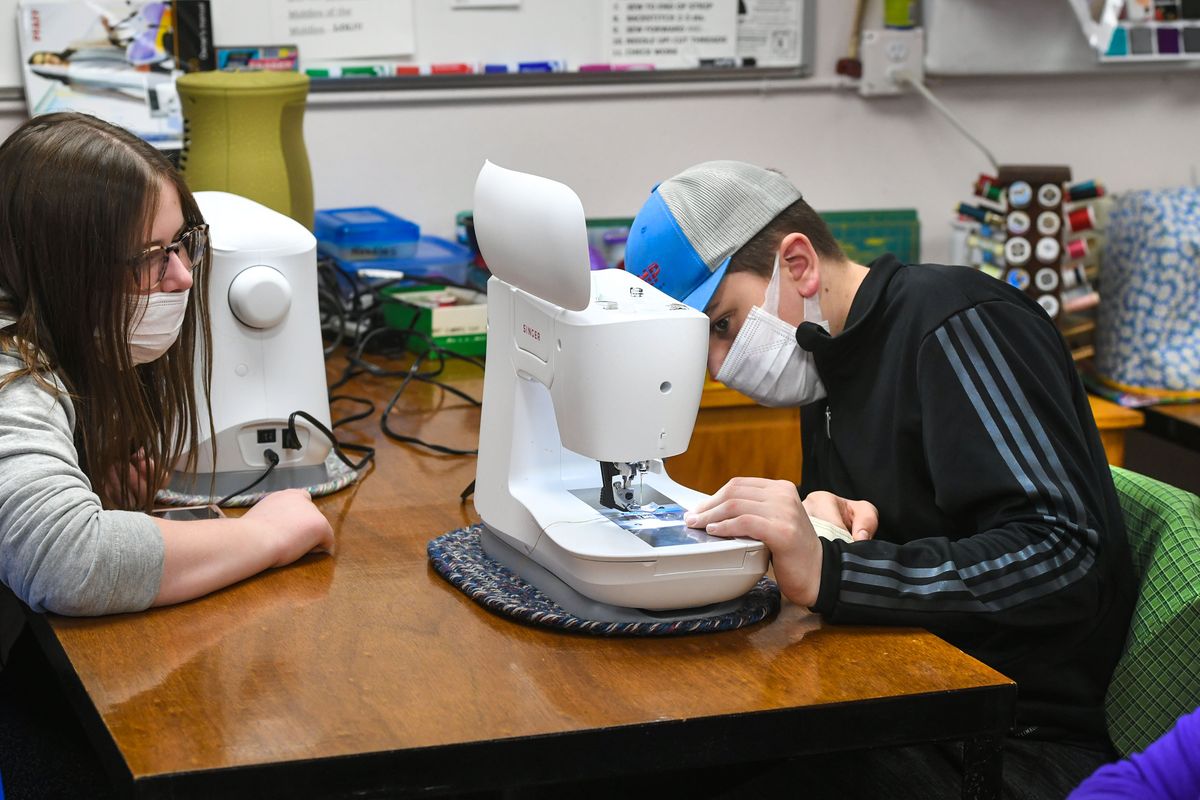Sewing surge: Younger generations in Spokane are seeking out seams in the homespun hobby

While sewing has gained in popularity this year for many ages as a homespun hobby, it’s gone beyond making face coverings. Young adults have helped press that seaming interest.
The younger populations who are learning to sew include people who use thrift store material to make vintage-inspired attire. Others want to create home décor or simply fix what they have, and they’re learning the craft from classes, parents, grandparents and YouTube.
But buying a basic sewing machine in Spokane has remained challenging for several months because of demand and backorders, said Elizabeth Pike, local owner and instructor at Let’s Get Sewing. Meanwhile, people also have dusted off older family equipment, perhaps grandma’s Singer.
“Among college-aged or young mothers, I do see a lot more involvement,” Pike said. “I think people are more interested in being self-sufficient and being able to make things.
“A lot of the younger people are interested in not having to always go out and buy new clothes. They want to fix the ones they have, or they want to upcycle them into something else.”
That includes women and men. “Three weeks ago, I had two young men in my class,” Pike said.
While she sees that more people want to learn how to sew, “For the young adults in the group I had here a couple weeks ago, the problem is the entry-level machines are hard to find.”

Pike’s school, in a 1,000-square-foot room, has equipment spaced apart for weekly classes, including ones geared toward kids. Limited to five people each, most sessions have remained full the past several months.
Recently, she’s also seen an interest among her own grown children.
“When they were young, none of them wanted to learn, but now all of a sudden, everybody wants to sew. It’s like it skipped a generation, almost. And it might tie into this minimalist thing that’s going around that means we don’t buy a whole lot of stuff, and we fix what we do have.”
Although it isn’t always cheaper to make clothes than to buy them, she said people want to make apparel fit better or create what’s different than what stores offer. Some students have bought large-sized outfits at thrift stores to cut and make into clothes, or people make cosplay costumes.
Spokane resident Julie Quinn, 25, took up sewing in the past six months after always having an interest. She points to trends among young adults on social media, mainly to repurpose fabrics found at thrift shops.
“What got me interested were these ladies taking tablecloths and curtains and creating historical clothing out of them,” Quinn said. “Also, there is a whole thing on social media about how awful fashion is today, so when you’re repurposing used fabric, you’re completely circumventing the entire fashion industry.”
One woman who has inspired Quinn is Rachel Maksy with her YouTube tutorials on sewing 1950-60s’ fashions such as long skirts made from thrift shop materials. Quinn has since sewn three vintage-style skirts for herself from secondhand store finds. Another skirt with pleats is next.
“I have heard of a lot of people doing this,” she said. “When I go to thrift shops and get to the register, they’re always asking me, ‘What are you doing? I see girls your age buying up these fabrics and tablecloths.’ It’s a great conversation starter.”
Experiments to make clothes for her 7-year-old daughter haven’t worked so far, but Quinn is happy with her skirts. “I’ve done a patchwork skirt where I just bought a bunch of different shirts of the materials I liked and sewed it all together.
“The goldmine is king-sized flatbed sheets if you can find those because they are the easiest to work with – it’s been trial and error right now.”
Isabella Weiand, 22, regularly sews for her Spokane job but first became interested through high school theater and then assisting with costumes for Spokane Civic Theatre. But a family member got her started.
“My grandma on my dad’s side sewed a little bit,” Weiand said. “She actually helped me with my first project and got me a sewing machine. From there, it just kind of took off.”
After her University of Idaho graduation in costume design and technology, she landed a job as a Disneyland costumer – designing and sewing for the animatronic costumes. She returned to Spokane around May after Disneyland closed because of the pandemic and started doing bridal work.
“Young people I know are starting to sew,” she said. “There have been a lot more people who are getting into it, and I know quite a few younger people who have gotten into quilting, too.”
That older equipment can work well. Weiand’s favorite sewing machine is an older-model Singer in a table.
“It’s from like 1935 or something. It’s the only one I trust. My favorite part is it has this giant foot that I put on, and it does automatic buttonholes, and they’re even better than the computerized ones you can get.”
Scot Auble, co-owner of the Quilting Bee in Spokane Valley, also has witnessed this year’s dusting off of older sewing machines.
“Especially when the need for mask-making arose, our service department just got inundated with old machines that had been pulled out of the closet and dusted off and maybe weren’t working so well,” Auble said.
The Quilting Bee supported a volunteer-led project for people to sew about 36,000 face coverings needed in the community during the pandemic.
While that has slowed, Auble said he also has noticed more young adults and kids taking up sewing. Some of it is tied to seeing projects on Etsy or Pinterest to make quilts, purses, pillows or other home decorations. Occasionally, a group of parents who are home-schooling together will buy a couple of sewing machines so kids can learn on them, he said.
“There is a lot of reuse of things, too, with people going down to Goodwill or a thrift store and buying stuff to repurpose. We’re seeing a lot of young people who are really super active in garment-making.
“That kind of waned for years, but now garment-making is making a comeback for the younger group because they like to make unique stuff.”
Auble said more of Quilting Bees’ stocked sewing machines have trickled in after shortages, although there’s still some on backorder.
Pike has noticed less selection for buying fabrics – narrowed down mainly at Joann, Hobby Lobby, Walmart and local quilt shops.
It’s mostly cotton material, she said, so it’s difficult to find other fabrics. Depending on where, the stock of entry-level sewing machines still might be low.
“I think I was at the Shadle Walmart a couple of days ago,” Pike said. “Anything $200 and below is pretty much gone.”